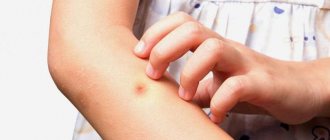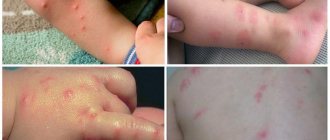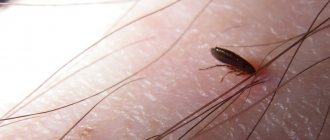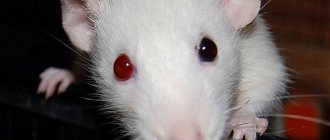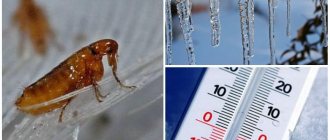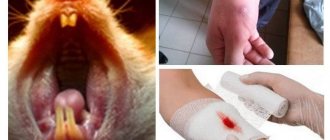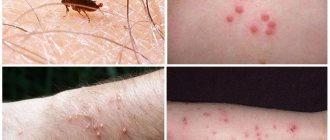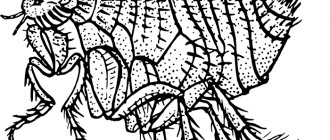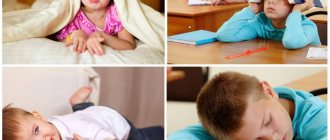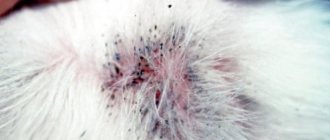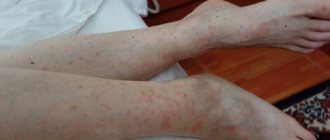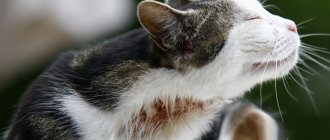- Types of fleas that attack people
- Symptoms of flea bites in a child
- How dangerous are flea bites for a child?
- Drug treatment of flea bites in children
- Traditional medicine methods
- How to reduce pain from bites
- Activities to help prevent flea bites
- Fighting parasites in the apartment
Flea bites in children are painful and often cause an allergic reaction. Scratching wounds is dangerous due to secondary infection and the appearance of pustular rashes that develop into pyoderma and ulcers. Let's consider what to do if fleas have bitten a child, what to apply and how to treat.
Types of fleas that attack people
These blood-sucking parasites are found throughout the world. There are more than 2,000 species of fleas, and all of them are dangerous to humans. Of these, the most common are:
- Feline. In cities where cats are usually kept in apartments, these insects are rare. They infect animals in rural areas where cats run outside.
- Canine. Dogs regularly go outside for walks, where there is a high risk of parasite infection. Bloodsuckers pass from them to children.
- Rat. Parasites enter the apartment from the basements where rodents live. The danger of these insects is that they carry serious diseases. If a child is bitten by rat fleas, he is immediately shown to a doctor to prevent infection.
- Human. These fleas attack people and animals. They prefer children who have delicate and thin skin. Insects move easily in the hair, but after drinking blood, they leave the person. The parasites' bites are painful and they are very difficult to catch as they jump long distances. Usually insects settle in human dwellings, where they hide in secluded places.
What infections can fleas carry?
Parasites feed on the blood of healthy, sick and even dead people and animals. When a flea bites a person, the viruses enter the skin and are carried throughout the body through the blood.
The most dangerous diseases that bloodsucking animals can carry:
- anthrax;
- salmonellosis;
- encephalitis;
- typhus;
- tapeworms;
- fungal infections;
- listeriosis;
- tularemia;
- plague.
The greatest danger is posed by fleas that live on rats. These rodents feed on spoiled foods and dead animals and carry dangerous diseases.
If rats appear in the basement of the house, you need to destroy the rodents and carry out a complete treatment of the room. Companies specializing in disinsection and deratization can best cope with this task.
Symptoms of flea bites in a child
Fleas do not live on humans. These parasites attack people, pierce their skin with sharp jaws and drink blood. Having had enough, they jump off the victim’s body and hide in secluded places: under baseboards, in carpets and in upholstered furniture.
Parasites spread eggs throughout the house. Hair-covered larvae, nymphs, quickly emerge from them. They feed on organic debris and are often concentrated near the trash can. After 2 weeks, the larvae turn into adult insects and attack people and animals.
The signs of a flea bite in children are pronounced, unlike in adults. A blister up to two centimeters in diameter appears at the site of the bite. There is bruising under the skin and severe swelling around the blister.
Parents do not always understand that their child is being attacked by fleas and confuse their bites with mosquito bites. But flea bites have their own characteristics.
- Bites are concentrated on one area of the body. Most often they appear under the hair, on the legs and arms.
- A dense red spot appears around the bite, and in the center there is a blister filled with liquid.
- Children experience severe pain when fleas bite them.
- If you carefully examine the affected areas, you will see wounds through which the parasites sucked blood.
It is impossible to see jumping insects in a child's head; they do not lay eggs in the hair. But if the baby constantly scratches his head, and inflamed blisters are visible on the skin under the hair, then these are signs of a flea attack.
Babies who have been bitten by parasites complain of itching and pain. Their wounds become more inflamed than those of adults. Parents should immediately pay attention to the child’s complaints and find out their cause, because we are talking about the baby’s health.
If a child is attacked by bloodsuckers, take the following measures:
- relieve pain and itching in the baby, treat wounds from bites;
- destroy multiplied parasites in an apartment or house.
In the future, in order not to miss the appearance of bloodsuckers, the child’s legs, arms and head are carefully examined, and the hair is combed out with a fine comb.
Fleas bite children all over their bodies, since the skin is delicate and it is not difficult to bite through them. The itching from the bite is unbearable.
After the rash appears, the lymph nodes become enlarged. Some children have increased body temperature and stool upset. If such symptoms occur, you should contact your pediatrician.
If an infection is suspected, the doctor will give a referral for a blood test, since the composition of the blood plasma changes with repeated bites.
Common sites of injury
Insects do not choose the human body as their permanent residence. Here the temperature for their existence is low. They are comfortable living in carpets, upholstered furniture, grass and soil. In these places they lay eggs and hatch larvae. They only bite people. If there is an animal nearby, the insects fix their gaze on it.
Fleas, if necessary, can live for about a year and a half without food. But under normal conditions they eat repeatedly and greedily, receiving nutrition from the human body. The process of blood absorption lasts from a minute to several hours. Not all the blood is digested; a large amount is released with feces, which further increases irritation of the child’s skin.
As a rule, bite marks are found on the legs, arms, face and stomach, that is, on uncovered areas of the body. Individuals do not penetrate clothing and do not bite through it. Fleas feel great in a child’s head, leaving bite marks and spots. This can lead to such serious diseases as hepatitis, brucellosis, and anthrax.
Not all insects are infected, but if they see a similar problem on the baby’s head, they get rid of it urgently.
First, make sure that there are fleas in the child’s hair. You need to be able to distinguish them from lice. These insects require different approaches to treatment, and blood-sucking parasites can be recognized by the following signs:
- Fleas on children's heads are in constant motion; they do not stay in the hair part, but jump from one place to another, while lice live and lay eggs in the hair.
- The first ones jump on the head, and the second ones crawl.
- They are saved from lice by using special hair products and combing out nits. You won’t be able to get rid of fleas on children’s heads this way. Complete disinfection of the home, clothes and shoes, and pets is necessary.
How dangerous are flea bites for a child?
Flea bites on children's skin do not heal for up to 7 days. They cause hives, inflammation and other allergic reactions. In severe cases, the child develops Quincke's edema and anaphylactic shock, and multiple bites lead to bronchial asthma.
Children often scratch bite marks, causing dirt to become trapped in them. This leads to purulent inflammation. Parasites cause pulicosis in children, which is characterized by the following symptoms:
- temperature rises;
- lymph nodes swell;
- diarrhea appears;
- the child feels weak and has difficulty breathing.
- wounds form on the mucous membranes.
If these signs appear, you should consult a doctor immediately.
Another danger of parasites is that they are carriers of pathogens of serious diseases:
- encephalitis;
- brucellosis;
- typhoid fever;
- tularemia and others.
The saliva of bloodsuckers contains many bacteria and helminth eggs, which can be transmitted to children.
If a child is bitten by one or two fleas, this does not mean that he will definitely get sick. But when insects appear in a house in large numbers, the risk of infection increases significantly.
Drug treatment of flea bites in children
If flea bites are found on the baby’s skin, treatment begins immediately. If there is an allergic reaction, the pediatrician will prescribe allergy medications. Take them according to the recommendations, without exceeding the permissible dosage.
The wound is first washed with water and treated with disinfectants. The water should be cold so as not to increase irritation from the bite. Hydrogen peroxide, Chlorhexidine or Miramistin are suitable as an antiseptic.
Itching is relieved with a cotton pad soaked in a soda solution. Apple cider vinegar relieves the burning sensation.
Flea bite wounds for children are smeared with the following products:
- Boro-plus;
- Antiallergic gel Fenistil;
- Bepanten;
- Calamine lotion:
- Psilo-balm;
- Nezulin.
Before using medicinal balms, lotions, creams, the child is checked for an allergic reaction. First, the product is applied to the baby’s wrist. If redness is not observed, the drug can be used.
Why is the danger of flea bites greater for children than for adults?
- A child’s skin is thinner and more vulnerable – so a flea bite is especially painful, it can be scratched and does not go away for a long time.
- Children are prone to allergies because... their immune system is weaker than that of an adult.
- The flea is a carrier of infections and eggs of most helminths (we talk in more detail about the danger of fleas to humans here).
Traditional medicine methods
Traditional medicine recipes will help cure flea bites in a child.
A mixture of dandelion juice, parsley leaves and plantain relieves inflammation well. Add a grated clove of garlic to the juice and apply the mixture as a compress to the wounds. The procedure lasts 20 minutes, after which the compress is washed off from the skin.
A solution of ammonia will help relieve itching. Dissolve 5 grams of soda and 5 ml of ammonia in 200 ml of water. The compress is applied for 10 minutes. If the child complains of a burning sensation, the bandage should be removed from the skin.
If there are a lot of bites on the child’s body, they are lubricated with a mixture of honey and lemon juice. To do this, dilute 5 grams of honey in 100 ml of lemon juice. Apply the product to the skin with a cotton swab and wash off after 10 minutes.
If a child scratches the wounds, they are dried with brilliant green or sulfur ointment. To prevent repeated scratching, the bite sites are secured with a bandage.
Pharmacology
The ointment exerts its antimicrobial and antiparasitic effect upon contact with the skin. It interacts with substances of organic origin, resulting in the formation of sulfides and pentathionic acid. They make sulfur ointment a natural antiseptic.
When in contact with the skin, the components of sulfur ointment are not absorbed into the blood, which means they do not have a systemic effect on the body: they do not put a strain on the liver, do not require filtration by the kidneys, and do not affect the functioning of other internal organs.
How to reduce pain from bites
To relieve itching and inflammation in the affected areas, use the following remedies:
- the wound and the aureole around it are lubricated with hydrocortisone or other medicinal ointments;
- apply hot and cold compresses to relieve pain;
- inflammation is relieved by baby lotion, a mixture of tea tree and almond oils;
- itching is reduced by warm water, to which a teaspoon of soda and ammonia have been added.
If complications arise, consult a doctor for treatment with antihistamines and sedatives. To repel fleas from the scalp, take the following measures:
- Wash your hair and scalp with tar soap. Its smell cannot be tolerated by parasites.
- The affected areas are treated with brilliant green or hydrogen peroxide.
- Aloe juice, which is applied to the scalp, helps against parasites. This remedy repels fleas and heals wounds.
General information
An ointment based on sulfur is widely used for various diseases of the dermis. The simple composition makes the ointment accessible to different segments of the population, because prices per jar start at only 28 rubles.
The drug is used not only to relieve unpleasant symptoms, but also as the main medicine that can eliminate the cause of the disease. The main component, which is sulfur in its pure form, better known as a chemical element, is supplemented by the following auxiliary substances:
- petrolatum;
- water;
- emulsifier.
In the pharmacy you can find sulfur ointment packaged in glass jars with a plastic lid or in aluminum tubes.
Activities to help prevent flea bites
Carrying out preventive measures will help prevent the occurrence of bites in children.
So what to do:
- If there are animals at home, flea products in the form of drops and shampoos are constantly used. Dogs and cats are given a therapeutic collar.
- Any contact of a child with homeless animals from the street is prohibited.
- For preventive purposes, once a month the apartment is treated with products that repel fleas.
If suspicious symptoms appear, you should contact your pediatrician. Self-medication is categorically unacceptable in the case of young children.
Indications for the use of sulfur ointment
Due to its antiseptic properties, sulfur ointment is actively used for various dermatoses:
- fungal;
- bacterial;
- parasitic.
Therefore, with the help of ointment alone, if used correctly, you can cure skin diseases such as:
- lichen;
- foot fungus;
- scabies;
- seborrheic dermatitis;
- acne;
- pigmentation;
- acne;
- demodicosis
It is separately noted that such a complex and untreatable disease as psoriasis can be stopped through the use of sulfur ointment. Psoriasis is a skin disease that is not associated with parasites or fungal infections. It is classified as a genetic disease. As a result of disturbances in the rate of cell division, growths appear. They are filled with small capillaries. When they are mildly affected, bleeding begins, which is difficult to stop.
In this case, sulfur ointment reduces the risk of secondary infection of psoriasis wounds, which, in turn, reduces the incidence of itching. Without touching the growths to scratch, the patient does not tear them until they bleed and does not increase the wounds. Thus, sulfur ointment helps to minimize the spread of ulcers throughout the body.
Fighting parasites in the apartment
To get rid of parasites, animals in the house are treated with insecticides. They are washed with flea shampoo, treated with sprays and put on flea collars.
In all rooms, floors are washed, carpets and upholstered furniture are vacuumed, floors and walls are treated with aerosol insecticides or dust is spread. Mattresses are sprayed with insecticides and bed linen is changed. If fleas enter an apartment from the basement or attic, they contact the sanitary and epidemiological station to destroy them.
To prevent re-infestation by fleas, preventive measures are taken:
- The child is regularly examined to detect parasites in time.
- Bed linen is changed frequently.
- Pets are removed from the children's room.
- The child is not allowed to communicate with stray cats and dogs, or to pet or hug them.
If flea bites are found on the baby’s skin, then urgent measures are taken to get rid of the bloodsuckers, otherwise they will quickly multiply in the house. The apartment and the pets living in it are treated with anti-parasite agents. Bite wounds are lubricated with medicinal preparations, and the head is washed with tar soap.
